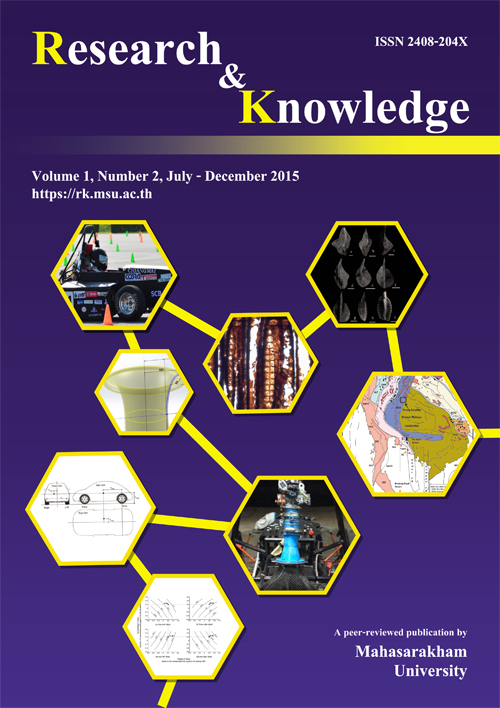New fossil woods from the Mesozoic Khorat Group of Thailand and their palaeoecological implications
Keywords:
Fossil wood, Mesozoic, Thailand, palaeobiogeography, taxonomyAbstract
Despite its limited stratigraphical value, fossil wood has been revealed to be of interest to characterize the palaeoenvironment evolution during the sedimentation of the Khorat Group. It helps understand the ecosystems in which the rich Thai Dinosaur faunas evolved. The available Khorat group fossil wood record was, however, mostly from the northeastern Thailand (Isan). New data are presented here, from the southwestern Isan provinces of Chaiyaphum and Nakhon Ratchasima. Although 17 new samples were studied, specific diversity was not increased, which suggests that the taxonomical investigation of the Khorat wood record is quite complete. Fossil wood from the Phu Phan Formation is reported for the fi rst time, and assigned to the genus Shimakuroxylon. Despite being sedimentologically similar, the Phra Wihan and Phu Phan formations seem to yield different woods, which suggests that they may have had different palaeoecology or provenance.
References
Booth, J. and Sattayarak, N. 2011. Subsurface Carboniferous –Cretaceous geology of north-eastern Thailand. In: Ridd, M. F., Barber, A. J. and Crow, M. J. (Eds), The geology of Thailand. Geological Society London, pp. 185-222.
Department of Mineral Resources. 2007. Geological map of Thailand, Scale 1:2,500,000. Ministry of Natural Resources and the Environment of Thailand.
Hass, H. and Rowe, N. P. 1999. Thin section and wafering. In: Jones, T.P. and Rowe N. P. (Eds.), Fossil Plants and Spores: Modern Techniques. Geological Society London, pp. 76-81.
Mouret, C, Heggemann, H, Gouadain, J. and Krisadasima, S. 1993. Geological history of the siliciclastic Mesozoic strata of the Khorat Group in the Phu Phan Range area, northeastern Thailand. In: Thanasupthipitak T. (Ed.). Proceedings of the International Symposium on the biostratigraphy of mainland Southeast Asia: Facies and palaeontology. Chiang Mai University, pp. 23-49.
Philippe, M. 2011. How many species of Araucarioxylon? Comptes Rendus Palevol 10, 201-208.
Philippe, M., Szakmany, G., Gulyas-Kis, C. and Jozsa, S. 2000. An Upper Carboniferous-Early Permian silici fi ed wood in the Miocene conglomerate, from the Western Mecsek Mts. (Southern Hungary). Neues Jahrbuch für Geologie und Paläontologie, Monatshefte 2000 (4), 193-204.
Philippe, M., Suteethorn, V., Lutat, P., Buffetaut, E., Cavin, L., Cuny, G. and Barale, G. 2004. Stratigraphical and palaeobiogeographical signi fi cance of fossil wood from the Mesozoic Khorat Group of Thailand. Geological Magazine 141 (3), 319-328.
Philippe, M., Suteethorn, V. and Buffetaut, E. 2011. Une nouvelle espèce du genre Brachyoxylon dans le Crétacé inférieur d’Asie du Sud-Est. Géodiversitas 33 (1), 25-32.
Philippe, M., Boura A., Oh, C. and Pons, D. 2014. Shimakuroxylon a new homoxylous Mesozoic wood genus from Asia, with palaeogeographical and palaeoecological implications. Rev. Palaeobotany Palynology 204, 18-26.
Songtham, W., Grote, P. J. and Chitnarin, A. 2011. Field excursion guide book for Route 2. World Conference on Palaeontology and Stratigraphy, Nakhon Ratchasima, 27 November – 2 December, pp. 17.
Wang, Y., Zhang, W., Zheng, S., Jintasakul, P., Grote, P. J. and Boonchai, N. 2006. Recent advances in the study of Mesozoic–Cenozoic petri fi ed wood from Thailand. Progress in Natural Science 16, 501–506.
Downloads
Published
How to Cite
Issue
Section
License

This work is licensed under a Creative Commons Attribution-NoDerivatives 4.0 International License.








